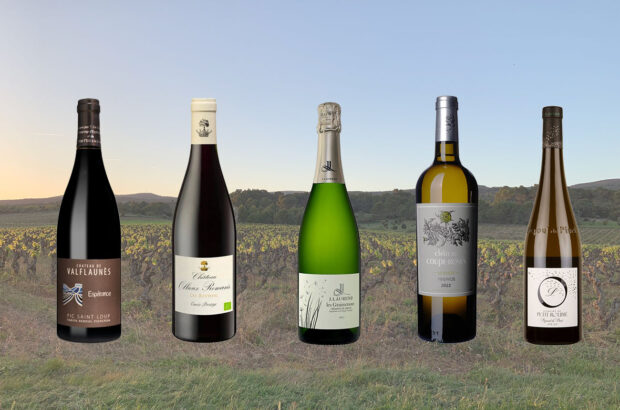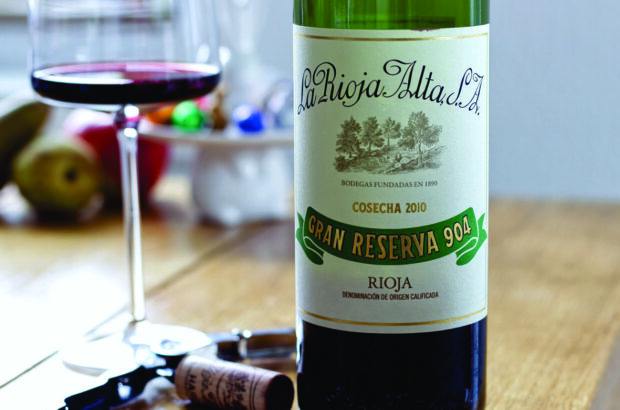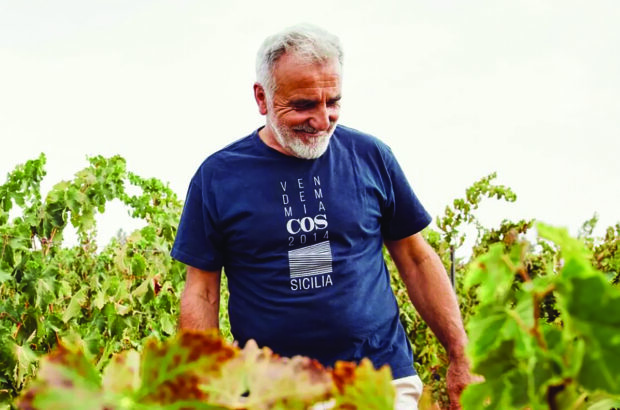Travelling through the Rhône Valley one begins to wonder whether the marriage of Syrah and Grenache is really a match made in heaven or whether the blend was born from a necessity to make peace between north and south. The Northern Rhône prides itself in its Syrah symbolism while the south tries to temper the greedy Grenache. Syrah can produce great wine without the help of its southern neighbour, but Grenache needs a serious amount of attention to produce a fabulous one-grape show. The question of a pre-nuptial agreement needs to be addressed, however, before marriage is seriously considered. Some may argue that Grenache, with its ability to produce huge quantities and high alcohol, cannot stand tall without the injection of colour and gravitas which the Syrah brings as its dowry. This argument is flawed. To understand how the marriage works one must look at the personalities of the individuals when they are in their prime and how they interact with soil and climate – the elusive rules of terroir.
In the Rhône there are five main soil types which affect the vines in different ways: shingle, clay-like limestone, soil layered with large stones, silt and sand. The Valley’s climate is characterised by seasons of rain, warm temperatures and broad strokes of sunshine. One could ascribe these virtues to many wine-growing areas but there is one further major influence – the Mistral wind which gusts up through the Avignon-Vienne tunnel created by the Cévennes mountains to the south and west, and the foothills of the Alps in the east.The combinations of microclimate, soil and vine, matched with the diversity of winemakers’ skills, create a bit of a headache. In past years it was individual experience based on tradition that determined how a particular wine would turn out. Things have changed. Although the presence of a Rhône-wide wine body is not a new invention, Inter Rhône – the professional organisation which oversees the Institut Rhodanien in Orange – has forged ahead since its brand-new research centre and college opened in 1995. Every aspect of wine production in the Rhône is covered here, and not just from the confines of a laboratory. The Institut’s director, Christophe Riou, is charged with implementing quality in the field, literally. This involves carrying out quality diagnosis from the vineyard onwards; maintaining an emphasis on training; encouraging the circulation of information on grape varieties, terroir, yeasts and root stocks; ensuring traceability; and reinforcing quality control on bottles sold both on the domestic and international markets. The latter task actually involves going shopping and bringing back previously assessed wines to check their authenticity and the effects which distribution and supermarket shelving has had on them.
The Institut’s big seminar last year, ‘Everything you wanted to know about Grenache’, presented research done over five years producing wines ‘in miniature’ from 25 plots dotted around the (mostly southern) parts of the Valley. The vines were pruned, green-harvested, vinified and assessed in as near laboratory conditions as possible. The role is to educate rather than police and, with more than 8,000 wine-growing properties producing AC wines in the Valley, it’s a mammoth task. But they do it with great style – it was particularly impressive to see 14 year-olds on a viticulturalists’ course (presumably with some dispensation for underage drinking).
CHARACTER TRAITS
{"content":"PHA+U28sIGJhY2sgdG8gdGhlIGdyYXBlcy4gU3lyYWggaXMgdGhlIG9ubHkgcmVkIGdyYXBlIGFsbG93ZWQgaW4gdGhlIE5vcnRoZXJuIFJow7RuZSBjcnVzIGFuZCBjYW4gY3JlYXRlIG1hZ2ljYWwgd2luZXMgYnVyc3Rpbmcgd2l0aCBzcGljZSBhbmQgcG93ZXIuIFRoZXNlIGNhbiwgaW4gdGltZSwgZGV2ZWxvcCBpbnRvIHdpbmVzIHdoaWNoIGRpc3BsYXkgYSByYXRoZXIgZGFuaywgYW5pbWFsIGNoYXJhY3RlciB3aGljaCwgYXQgYmVzdCwgbmVlZCBpbmZvcm1lZCBhcHByZWNpYXRpb24gYW5kIGNhbiwgYXQgd29yc3QsIGJlIHF1aXRlIHVuYXBwZXRpc2luZy4gR3JlbmFjaGUgaXMgbGVzcyByZW5vd25lZC4gVGhlcmUgaXNuJiM4MjE3O3QgYSB2aWxsYWdlIHdoaWNoIGluc2lzdHMgb24gaXRzIHNvbGUgdXNlLiBBbmQgZm9yIHZlcnkgZ29vZCByZWFzb24uIEl0IGNhbiBiZSBhIHdlZWQgaW4gdmluZSB0ZXJtcywgcHJvZHVjaW5nIGh1Z2UgcXVhbnRpdGllcyBvZiBkaWx1dGUgZ3JhcGVzIHdoaWNoIGxhY2sgc3RydWN0dXJlIGFuZCBkZXB0aC4gSXQgZG9lcywgaG93ZXZlciwgY29tZSBpbnRvIGl0cyBvd24gd2hlbiBuYXR1cmUgYW5kIHRoZSB2aXRpY3VsdHVyYWxpc3Qgd29yayBpbiBoYXJtb255LiBXaXRoIG9sZCB2aW5lcywgYnJ1dGFsIHBydW5pbmcgYW5kIHRvdWdoIHNvaWxzLCB0aGUgdmluZSYjODIxNztzIGZsYW1ib3lhbmNlIGlzIHJlc3RyaWN0ZWQgYW5kIHRoZSByZXN1bHRpbmcgZ3JhcGVzIHNob3VsZCBiZSBhcyBmaWVyY2VseSBjb25jZW50cmF0ZWQgYXMgcG9zc2libGUuQ29uY2VudHJhdGlvbiBvZiB0aGUgU3lyYWggbWF5IG5vdCBvbmx5IG1lYW4gcG93ZXJmdWwsIGhpZ2ggY29sb3VyZWQgZnJ1aXQgYW5kIGFyb21hdGljIG5vdGVzIG9mIHZpb2xldCBhbmQgcGVwcGVyLCBidXQgYWxzbyBkYW5nZXJvdXNseSBoaWdoIHRhbm5pbnMuIEFzIGEgZm9pbCwgdGhlIEdyZW5hY2hlIHByb3ZpZGVzIHNvbGlkIHdhcm10aCBhbmQgc3VwcGxlbmVzcyB3aXRoIGl0cyByZWxhdGl2ZWx5IGxvdyBhY2lkaXR5LiBUaGlzIGlzIHdoZW4gdGhlIGJsZW5kIHdvcmtzIOKAkyBpdCYjODIxNztzIGEgc2VyaW91cyBtYXJyaWFnZS4gVGhlcmUgaXMgYSB0cmVuZCBmb3IgbW9yZSBhbmQgbW9yZSB3aW5lcyB0byByZXZlbCBpbiB0aGUgaWRlYSB0aGF0IHRoZXkgc2hvdWxkIHJlbWFpbiBiYWNoZWxvcnMuIFN5cmFoIHdhbnRzIHRvIHNob3cgb2ZmIHdpdGhvdXQgdGhlIGhlbHAgb2YgYW55dGhpbmcgZWxzZSDigJMgZXhjZXB0IHBlcmhhcHMgYSBsaXR0bGUgVmlvZ25pZXIgdG8gYWRkIGEgZmxvcmFsIG5vdGUgaW4gYSBicm9vZHkgQ8O0dGUgUsO0dGllLCBvciBzb21lIE1hcnNhbm5lIG9yIFJvdXNzYW5uZSBpbiBTYWludC1Kb3NlcGggYW5kIEhlcm1pdGFnZS4gR3JlbmFjaGUgd2hpY2ggaGFzIGdyb3duIHRvbyBvbGQgdG8gbWFycnkgaXMgcXVpdGUgaGFwcHkgdG8gY29uY2VudHJhdGUgaXRzIGF0dGVudGlvbiBvbiBwcm92aWRpbmcgZHJpbmtlcnMgd2l0aCB0aGUgZnVsbG5lc3Mgb2YgY2hhcmFjdGVyIHRoYXQgY29tZXMgd2l0aCBhZ2UuQXQgVmlldXggVMOpbMOpZ3JhcGhlLCBEYW5pZWwgQnJ1bmllciBjb25zaWRlcnMgdGhhdCBHcmVuYWNoZSBpcyB0aGUgYXJ0aXN0JiM4MjE3O3M8L3A+CjxwPmNhbnZhcyB0aGF0IHByb3ZpZGVzIGEgZm91bmRhdGlvbiBvbiB3aGljaCB0byBidWlsZCBoaXMgQ2jDonRlYXVuZXVmLWR1LVBhcGUuIFRoZSBncmFwZSBwcm92aWRlcyBhbGNvaG9sLCBsb3cgdGFubmluIGFuZCByaWNoIHBlcmZ1bWUgaW4gaGlzIGJsZW5kIGJ1dCB0aGUgaW50cm9kdWN0aW9uIG9mIDIwIOKAkyAzNSUgb2Ygb3RoZXIgdmFyaWV0YWxzIGFkZHMgb3RoZXIgbnVhbmNlcyB0byBhaWQgY29tcGxleGl0eS4gTWFueSBvdGhlciBwcm9kdWNlcnMgZmVlbCB0aGF0IFN5cmFoIGlzIHRoZSBuZXh0IG1vc3QgaW1wb3J0YW50IHBhcnQgb2YgdGhlIHJlY2lwZSwgYnV0IEJydW5pZXIgdGhpbmtzIHRoYXQgaXQgc2hvdWxkIG9ubHkgdGFrZSBwcmVjZWRlbmNlIG92ZXIgb3RoZXIgdmFyaWV0aWVzIHdoZW4gdGhlIHZpbnRhZ2UgdGVsbHMgaGltIHNvLiBJbiBhIGdvb2QgeWVhciwgTW91cnbDqGRyZSBjYW4gYmUgYSBmaWxsaXAgdG8gdGhlIHJlbGF0aXZlIGF1c3Rlcml0eSBvZiB0aGUgU3lyYWggd2l0aCBpdHMgYmFjay1zbGFwcGluZywgdGFycnkgZnJ1aXQgYWRkaW5nIGNvbG91ciwgc3RydWN0dXJlIGFuZCBhbnRpb3hpZGFudCBwcm9wZXJ0aWVzIHRvIHRoZSBibGVuZC4gQXMgQ2jDonRlYXVuZXVmIGlzIHByZXR0eSB3ZWxsIHRoZSBub3J0aGVybiBsaW1pdCBmb3IgcmlwZW5pbmcgTW91cnbDqGRyZSwgaXRzIHNsb3cgZGV2ZWxvcG1lbnQgY2FuIG1ha2UgaXQgc3VzY2VwdGlibGUgdG8gbGF0ZSByYWlucyBhbmQgc3Vic2VxdWVudCBkaWx1dGlvbiwgcmVuZGVyaW5nIGl0IHVzZWxlc3MgaW4gYSB0b3AtY2xhc3Mgd2luZS5NaWNoZWwgQ2hhcG91dGllciYjODIxNztzIENow6J0ZWF1bmV1Zi1kdSBQYXBlLCBieSBjb250cmFzdCwgaGFzIHRoZSBwZWN1bGlhcml0eSDigJMgZXNwZWNpYWxseSBpbiBhbiBhcHBlbGxhdGlvbiB3aGljaCBhbGxvd3MgdGhlIHVzZSBvZiAxMyBncmFwZSB2YXJpZXRpZXMg4oCTIG9mIGJlaW5nIG1hZGUgc29sZWx5IGZyb20gR3JlbmFjaGUuIEFuZCB0aGVyZSBpcyBubyBiZXR0ZXIgZXhhbXBsZSB0aGFuIGhpcyAmIzgyMTY7QmFyYmUgUmFjJiM4MjE3Oywgd2hlcmUgOTAteWVhci1vbGQgdmluZXMgc3RydWdnbGUgdGhyb3VnaCBzdG9uZXkgc29pbHMgdG8gcHJvZHVjZSBzdWJsaW1lIGNvbmNlbnRyYXRpb24sIGEgZGVlcCBydWJ5IGNvbG91ciBhbmQgYSBodWdlIGFtb3VudCBvZiBhbGNvaG9sLiBBbmQgdGhlcmUgaXQgaXMuIFRoZSBtYXJyaWFnZSBvZiB0aGUgdHdvPC9wPgo8cD48ZGl2IGNsYXNzPSJhZC1jb250YWluZXIgYWQtY29udGFpbmVyLS1tb2JpbGUiPjxkaXYgaWQ9InBvc3QtaW5saW5lLTIiIGNsYXNzPSJpcGMtYWR2ZXJ0Ij48L2Rpdj48L2Rpdj48L3A+CjxwPnByaW1hcnkgUmjDtG5lIHZhcmlldGFscyBpcyBiYXNlZCBvbiB0aGVpciBpbmRpdmlkdWFsIGNoYXJhY3RlcnMuIFRoZXJlIGlzIG5vIHNldCByZWNpcGUuIEl0IGlzIHRoZSBjb21iaW5hdGlvbiBvZiBtYW55IGRpZmZlcmVudCBwYXJ0cyB3aGljaCBtYWtlIHRoZSB3aG9sZS4gUmjDtG5lIHdpbmVtYWtlcnMgbXVzdCB1bmRlcnN0YW5kIHRoZSBzb2lsIGFuZCBhbGxvdyB0aGUgdmluZXMgdG8gZXhwcmVzcyB0aGVtc2VsdmVzLCBidXQga25vdyB3aGVuIHRvIGNoZWNrIHRoZWlyIHBlcmZvcm1hbmNlLiBUaGlzIG1lYW5zIHByb2R1Y2luZyB3aW5lcyB3aGljaCByZWxhdGUgdG8gdGhlIHZhZ2FyaWVzIG9mIHRoZSBjbGltYXRlIGluIGFueSBwYXJ0aWN1bGFyIHllYXIuIFRoZSBjbGltYXRlIGFsc28gbWVhbnMgdGhhdCBjb25zdW1lcnMgd29uJiM4MjE3O3QgZ2V0IGEgdW5pZm9ybSwgaW50ZXJuYXRpb25hbC1zdHlsZSB3aW5lLCBidXQgYXMgbG9uZyBhcyB0aGUgbWVhc3VyZXMgYXJlIGluIHBsYWNlIHRvIGVuc3VyZSByZWxpYWJpbGl0eSwgdGhlbiB0aGF0JiM4MjE3O3Mgd2hhdCBpdCYjODIxNztzIGFsbCBhYm91dC4gVml2ZSBsYSBkaWZmZXJlbmNlISBQZXJoYXBzIG5vdCB0aGUgc29ydCBvZiB0aGluZyBvbmUgc2F5cyBvbiBiZW5kZWQga25lZSwgYnV0IHRoaXMgbWVzc2FnZSBpcyB0aGUgZm9jdXMgb2YgdGhlIG5ldyBDw7R0ZXMgZHUgUmjDtG5lIFVLIGFkdmVydGlzaW5nIGNhbXBhaWduIChzZWUgTmV3cywgcGFnZSAyOCkuIFRoZSBtdWNoLWhlcmFsZGVkICYjODIxNjt0cmlvJiM4MjE3OyBvZiBncmVhdCB2aW50YWdlcyDigJMgMTk5OCwgMTk5OSBhbmQgMjAwMCDigJMgaWxsdXN0cmF0ZSB0aGUgcG9pbnQgYWJvdXQgdmFyaWF0aW9uLiBUaGlzIHdhcyBjZXJ0YWlubHkgYSBtYXJ2ZWxsb3VzIHJ1biBidXQgdGhlIHllYXJzIHdlcmUgdmVyeTwvcD4KPHA+ZGlmZmVyZW50LiBBbHRob3VnaCBlYWNoIHdhcyBvcHVsZW50LCAxOTk4IGZhdm91cmVkIEdyZW5hY2hlIHdoaWxlIDE5OTkgd2FzIFN5cmFoJiM4MjE3O3MgdHVybi4gSWYgYW55dGhpbmcsIHRoZXkgd2VyZSB2ZXJ5IHNpbWlsYXIgdG8gdGhlaXIgY291bnRlcnBhcnRzIGV4YWN0bHkgYSBkZWNhZGUgYWdvLiBBbiBvdmVydmlldyB3b3VsZCBpbmRpY2F0ZSB0aGF0IHRoZSB0b3AgMTk5OCB3aW5lcyBhcmUgYmlnLCBicm9vZHkgYW5kIG11c2N1bGFyIGFuZCB3aWxsIG5lZWQgdGltZSB0byBkZXZlbG9wIHRoZWlyIGNsYXNzaWMgc3R5bGVzLiBUaGUgMjAwMCB2aW50YWdlLCBvbiB0aGUgb3RoZXIgaGFuZCwgaXMgaHVnZWx5IGdlbmVyb3VzIHdpdGggZ3V0c3ksIGZvcndhcmQgZnJ1aXQsIGFuZCB0aGUgMTk5OSB3aW5lcyBmYWxsIHNvbWV3aGVyZSBiZXR3ZWVuIHRoZSB0d28sIHdpdGggYSBtb3V0aC13YXRlcmluZyBxdWFsaXR5IHdoaWNoIGlzIGJlYXV0aWZ1bGx5IGN1dCB3aXRoIGFjaWRpdHkgYW5kIHRhbm5pbiBpbiBhbGwgdGhlIHJpZ2h0IHByb3BvcnRpb25zLjwvcD4KPHA+TmljayBUYXJheWFuIGlzIGEgd2luZSBjb25zdWx0YW50IGFuZCB3cml0ZXIuPC9wPgo8ZGl2IGNsYXNzPSJhZC1jb250YWluZXIgYWQtY29udGFpbmVyLS1tb2JpbGUiPjxkaXYgaWQ9InBvc3QtaW5saW5lLTMiIGNsYXNzPSJpcGMtYWR2ZXJ0Ij48L2Rpdj48L2Rpdj4KPGgyPkJsZW5kczwvaDI+CjxwPkNow6J0ZWF1IEd1aW90LCBDb3N0acOocmVzIGRlIE7Drm1lcywgMjAwMCAoUHJlZG9taW5hbnRseSBHcmVuYWNoZSBhbmQgU3lyYWgpLiBJZiB0aGlzIGlzIGJhcmdhaW4gYmFzZW1lbnQsIHlvdSBuZWVkIGEgYmlnZ2VyIGJhc2VtZW50LiBTbW9rZXksIHNhdm91cnkgbm90ZXMgY29tZSBmcm9tIHRoZSBncmFwZSDigJMgdGhlcmUmIzgyMTc7cyBubyB3b29kLiDCozUuOTk7IE1hajwvcD4KPHA+TSBDaGFwb3V0aWVyLCAmIzgyMTY7QmVsbGVydWNoZSYjODIxNzssIEPDtHRlcyBkdSBSaMO0bmUsIDE5OTkgKDUwJSBHcmVuYWNoZSwgNTAlIFN5cmFoKS4gVGhpcyBpcyBhIHBlcmZlY3QgZXhhbXBsZSBvZiBob3cgdGhlIHR3byBtYWpvciBSaMO0bmUgdmFyaWV0YWxzIHdvcmsgdG9nZXRoZXIgdG8gcHJvZHVjZSBhIGxvdmVseSwgZWFzeSBzdHlsZS4gVGhlIGJlc3QgYXR0cmlidXRlcyBvZiBib3RoIGdyYXBlcyBhcmUgaGVpZ2h0ZW5lZC4gTWVuIENhdmUgZGVzIFZpZ25lcm9ucyBkZSBDaHVzY2xhbiwgJiM4MjE2O0xlcyBNb250aWNhdXRzJiM4MjE3OywgQ8O0dGVzIGR1IFJow7RuZSBWaWxsYWdlcywgMTk5OSwgKDUwJSBHcmVuYWNoZSwgNTAlIFN5cmFoKS4gVGhpcyBjdXbDqWUgZGlzcGxheXMgZ2VuZXJvdXMsIHNvZnQsIHN1cHBsZSBmcnVpdCBhbmQgd29uZGVyZnVsbHkgcm91bmRlZCB0YW5uaW5zLiBJdHMgaW1tZWRpYWN5IGlzIGhlbHBlZCBieSBhIHNob3J0IG1hY2VyYXRpb24gb2YgR3JlbmFjaGUgYW5kIDIwIGRheXMgZm9yIHRoZSBTeXJhaC4gVGhlIDIwMDAgJiM4MjE2O3ZpbGxhZ2UmIzgyMTc7IHdpbmUgaXMgYWxyZWFkeSBib3R0bGVkIGFuZCByZWFkeSB0byBwcm92aWRlIGEgdmVsdmV0eSBkcmluay48L3A+CjxkaXYgY2xhc3M9ImFkLWNvbnRhaW5lciBhZC1jb250YWluZXItLW1vYmlsZSI+PGRpdiBpZD0icG9zdC1pbmxpbmUtNCIgY2xhc3M9ImlwYy1hZHZlcnQiPjwvZGl2PjwvZGl2Pgo8cD5PZ2llciwgJiM4MjE2O0RvbWFpbmUgZGUgQ291cm9uJiM4MjE3OywgQ8O0dGVzLWR1LVJow7RuZSBWaWxsYWdlcywgMTk5OSAoNTAlIEdyZW5hY2hlLCAyMCUgU3lyYWggYW5kIDEwJSBlYWNoIG9mIE1vdXJ2w6hkcmUsIENpbnNhdWx0IGFuZCBDYXJpZ25hbi4pIEEgcmVhbCBSaMO0bmUgdmlvbGV0IGNoYXJhY3RlciB3aGljaCBpcyBkZXZlbG9waW5nIG5pY2VseSBhbmQgaGFzIGdvb2QgaG9sZGluZyB0YW5uaW5zLiBJZiBmb3VuZCwgY2hlY2sgb3V0IE9naWVyJiM4MjE3O3MgRHVjIGQmIzgyMTc7QWlndWlsbG9uLCBSw6lzZXJ2ZSBkZXMgVGVtcGxpZXJzLCBDZFIgMTk5OSwgd2hpY2ggaXMgd29uZGVyZnVsLiBNaXMgRG9tYWluZSBMZSBTYW5nIGRlcyBDYWlsbG91eCwgJiM4MjE2O1JvdWdlIExvcHkmIzgyMTc7LCBWYWNxdWV5cmFzLCAxOTk5ICg2MCUgR3JlbmFjaGUsIDQwJSBTeXJhaCkuIERlZXAgZ2FybmV0LCBnZW5lcm91cyBmcnVpdCBhbmQgZ3JlYXQgbGVuZ3RoIOKAkyBhIHZlcnkgc3R5bGlzaCB3aW5lIHdpdGggYSBzdG9uZXkgQ2jDonRlYXVuZXVmIGNoYXJhY3RlciB3aGljaCBkZW1hbmRzIGRyaW5raW5nIG5vdyBidXQgY291bGQgZWFzaWx5IHdhaXQgZml2ZSBvciBtb3JlIHllYXJzIOKAkyBmcm9tIDYwLXllYXItb2xkIEdyZW5hY2hlIGFuZCA0MC15ZWFyLW9sZCBTeXJhaCB2aW5lcy48L3A+CjxwPkNow6J0ZWF1IGRlIE1vbnRtaXJhaWwsICYjODIxNjtDdXbDqWUgZGVzIERldXggRnLDqHJlcyYjODIxNzssIFZhY3F1ZXlyYXMsIDE5OTkgKDcwJSBHcmVuYWNoZSwgMjAlIFN5cmFoLCAxMCUgTW91cnbDqGRyZSwgQ2luc2F1bHQpLiBDbGVhciBhbmQgYnJpbGxpYW50IGluIGNvbG91ciB3aXRoIGEgcG93ZXJmdWwgbm9zZSBvZiByaXBlIHJlZCBmcnVpdHMuIEJpZyBhbmQganVpY3kgaW4gdGhlIG1vdXRoIGFuZCBhIGZpbmlzaCB3aGljaCBnb2VzIG9uIGFuZCBvbi4gSGFsIE1haXNvbiBBcm5vdXggJmFtcDsgRmlscywgVmFjcXVleXJhcywgMTk5OSAoNzUlIEdyZW5hY2hlLCAyMCUgU3lyYWgsIDUlIE1vdXJ2w6hkcmUpLiBEZXNwaXRlIGl0cyBncmVhdCBjb21wbGV4aXR5LCBsdXNjaW91cywgc3dlZXQgZnJ1aXQgZ2l2ZXMgdGhpcyB3aW5lIGltbWVkaWF0ZSBhcHBlYWwuIEFydCBMZXMgVmlucyBkZSBWaWVubmUsICYjODIxNjtMZXMgQ3JhbmlsbGVzJiM4MjE3OywgQ8O0dGVzIGR1IFJow7RuZSBSb3VnZSwgMTk5OSAoNTAlIFN5cmFoLCA1MCUgR3JlbmFjaGUpLiBPbmUgb2YgdGhlIGJsZW5kcyBwZXJmb3JtZWQgYnkgdGhlICYjODIxNjtEcmVhbSBUZWFtJiM4MjE3OyBvZiBDdWlsbGVyb24sIEdhaWxsYXJkIGFuZCBWaWxsYXJkLiBXb25kZXJmdWxseSBjb25jZW50cmF0ZWQg4oCTIFJow7RuZSB0ZXJyb2lyIG1lZXRzIE5ldyBXb3JsZCBvcHVsZW5jZS48L3A+CjxkaXYgY2xhc3M9ImFkLWNvbnRhaW5lciBhZC1jb250YWluZXItLW1vYmlsZSI+PGRpdiBpZD0icG9zdC1pbmxpbmUtNSIgY2xhc3M9ImlwYy1hZHZlcnQiPjwvZGl2PjwvZGl2Pgo8cD5MZXMgVmlucyBkZSBWaWVubmUsICYjODIxNjtMZXMgT3TDqWxpw6llcyYjODIxNzssIENow6J0ZWF1bmV1Zi1kdS1QYXBlLCAxOTk5IChHcmVuYWNoZSAmYW1wOyBTeXJhaCBvbmx5KS4gUmljaCBhbmQgY2hvY29sYXRleSBvbiB0aGUgbm9zZSBhbmQgcGFsYXRlIGFuZCBidXJzdGluZyB3aXRoIHRvZmZlZWQgZnJ1aXQsIGJ1dCBuZXZlcnRoZWxlc3Mgc2hvd2luZyBhIGNlcnRhaW4gcmVzdHJhaW50IGFuZCB1bmRlcmx5aW5nIHN1YnRsZXR5LjwvcD4KPHA+RG9tYWluZSBkdSBWaWV1eCBUw6lsw6lncmFwaGUsIENow6J0ZWF1bmV1Zi1kdS1QYXBlLCAxOTk4ICg2NSUgR3JlbmFjaGUsIDE2JSBNb3VydsOoZHJlLCAxMiUgU3lyYWgsIDclIG90aGVyKS4gQ2xvc2luZyBkb3duIGJ1dCBzaG93aW5nIGVub3Jtb3VzLCBzb2Z0LCB2ZWx2ZXR5IHRleHR1cmVkLCBnYW1leSBmcnVpdCB3aXRoIGEgc3RlZWx5LCBzdHJ1Y3R1cmVkIGJhY2tib25lLiBUaGUgTW91cnbDqGRyZSBoaXRzIG91dC4gTCZhbXA7VzwvcD4KPHA+TGEgUm9xdWV0dGUsIENow6J0ZWF1bmV1Zi1kdS1QYXBlLCAxOTk5ICg3MCUgR3JlbmFjaGUsIDIwJSBTeXJhaCwgMTAlIE1vdXJ2w6hkcmUpLiBFbGVnYW50IGJhbGFuY2Ugd2l0aCBsaWdodCByZWQgZnJ1aXRzIGFuZCBvcmFuZ2UgcGVlbCBvbiB0aGUgcGFsYXRlLiBTb2Z0IGFuZCBjbGVhbiDigJMgYSBkZWxpZ2h0LiAoYm90dGxpbmcgSnVuZSAyMDAxKS4gTCZhbXA7VzwvcD4KPGgyPjEwMCUgR1JFTkFDSEU8L2gyPgo8cD5Eb21haW5lIGRlIGxhIEphbmFzc2UsICYjODIxNjtMZXMgR2FycmlndWVzJiM4MjE3OywgQ8O0dGVzIGR1IFJow7RuZSwgMTk5OSBGcm9tIDYw4oCTNzAteWVhci1vbGQgdmluZXMgYW5kIHZlcnkgbG93IHlpZWxkcy4gUG93ZXJmdWwsIGNoZXd5IGZydWl0IHdpdGggZ3JlYXQgY29uY2VudHJhdGlvbiBhbmQgc3RydWN0dXJlLiBDb3VsZCBkbyB3aXRoIGFub3RoZXIgeWVhci4gwqMxNi41MDsgU3dnPC9wPgo8cD5NIENoYXBvdXRpZXIsICYjODIxNjtMZSBCYXJiZSBSYWMmIzgyMTc7LCBDaMOidGVhdW5ldWYtZHUtUGFwZSwgMTk5OCBVbmJlbGlldmFibGUgaW50ZW5zaXR5IGFuZCBodWdlIGFsY29ob2xpYywgd2l0aCBhIHdlYWx0aCBvZiBhcm9tYXMgYW5kIGZsYXZvdXJzIHJ1bm5pbmcgdGhlIGdhbXV0IG9mIGxpcXVvcmljZSwgY2hvY29sYXRlIGFuZCB3aWxkIGJlcnJpZXMg4oCTIGEgcmVhbCBzdGFyIHByb2R1Y2VkIGZyb20gOTAteWVhci1vbGQgdmluZXMuIE1lbjwvcD4KPHA+U3RvY2tpc3QgY29udGFjdCBkZXRhaWxzIGZvciBhbGwgdGhlIHdpbmVzIGluIHRoaXMgZmVhdHVyZSBjYW4gYmUgZm91bmQgb24gcGFnZSAxNDYuPC9wPgo8cD5Eb21haW5lIGRlIGxhIEphbmFzc2UsICYjODIxNjtMZXMgR2FycmlndWVzJiM4MjE3OywgQ8O0dGVzIGR1IFJow7RuZSwgMTk5OSBGcm9tIDYw4oCTNzAteWVhci1vbGQgdmluZXMgYW5kIHZlcnkgbG93IHlpZWxkcy4gUG93ZXJmdWwsIGNoZXd5IGZydWl0IHdpdGggZ3JlYXQgY29uY2VudHJhdGlvbiBhbmQgc3RydWN0dXJlLiBDb3VsZCBkbyB3aXRoIGFub3RoZXIgeWVhci4gwqMxNi41MDsgU3dnPC9wPgo8cD5NIENoYXBvdXRpZXIsICYjODIxNjtMZSBCYXJiZSBSYWMmIzgyMTc7LCBDaMOidGVhdW5ldWYtZHUtUGFwZSwgMTk5OCBVbmJlbGlldmFibGUgaW50ZW5zaXR5IGFuZCBodWdlIGFsY29ob2xpYywgd2l0aCBhIHdlYWx0aCBvZiBhcm9tYXMgYW5kIGZsYXZvdXJzIHJ1bm5pbmcgdGhlIGdhbXV0IG9mIGxpcXVvcmljZSwgY2hvY29sYXRlIGFuZCB3aWxkIGJlcnJpZXMg4oCTIGEgcmVhbCBzdGFyIHByb2R1Y2VkIGZyb20gOTAteWVhci1vbGQgdmluZXMuIE1lbjwvcD4KPHA+U3RvY2tpc3QgY29udGFjdCBkZXRhaWxzIGZvciBhbGwgdGhlIHdpbmVzIGluIHRoaXMgZmVhdHVyZSBjYW4gYmUgZm91bmQgb24gcGFnZSAxNDYuPC9wPgo8cD5Eb21haW5lIEdpbGxlcyBSb2JpbiwgQ3JvemVzLUhlcm1pdGFnZSwgMTk5OSBIdWdlbHkgZXZvY2F0aXZlLCBzd2VldCBhbmQgc2F2b3VyeSBTeXJhaC4gQ29tcGxleCwgbW9kZXJuIHdpbmVtYWtpbmcgd2l0aCBhIGxlYXRoZXJ5IGVkZ2UuPC9wPgo8cD5Eb21haW5lIENvbWJpZXIsIENyb3plcy1IZXJtaXRhZ2UsIDIwMDAgQnVyc3Rpbmcgd2l0aCBsaXZlbHkgZnJ1aXQuIEhpcyAyMDAwcyBhcmUgdmVyeSBtdWNoIG1vcmUgc3BpY3ksIGV4Y2l0aW5nIGFuZCBjbGFzc3kgdGhhbiB0aGUgMTk5OXMuIEVuVzwvcD4KPHA+UGF1bCBKYWJvdWxldCBBaW7DqSwgRG9tYWluZSBkZSBUaGFsYWJlcnQsIENyb3plcy1IZXJtaXRhZ2UsIDE5OTkgQSBibG9ja2J1c3RlciBvZiBhIHdpbmUgd2l0aCBldmVyeXRoaW5nIGludGFjdCBidXQsIG5ldmVydGhlbGVzcywgdGhlIHRhbm5pbnMgYXJlIHNvIHJpcGUgdGhhdCB5b3UgYWxtb3N0IHdhbnQgdG8ga25vY2sgaXQgYmFjayByaWdodCBub3chIMKjMTEzIHBsdXMgVkFUIHBlciBjYXNlOyBMb2U8L3A+CjxwPkRvbWFpbmUgR2VyaW4sICYjODIxNjtMZXMgR3JhbmRlcyBQbGFjZXMmIzgyMTc7LCBDw7R0ZSBSw7R0aWUsIDE5OTkgQSByZWFsbHkgc3VjY3VsZW50LCBiaWcsIGJ1c3R5LCBicmlsbGlhbnRseSBzdHJ1Y3R1cmVkIHdpbmUg4oCTIGFuZCBpdCYjODIxNztzIGEgam95IHRvIGRyaW5rLiBDJmFtcDtDPC9wPgo8cD5EYW5pZWwgZXQgUm9sYW5kIFZlcm5heSwgQ8O0dGUgUsO0dGllLCAyMDAwIFRoZSB0aGluZyBhYm91dCB0aGUgVmVybmF5cyYjODIxNzsgd2luZXMgaXMgdGhhdCB0aGV5IGV4dWRlIGV4dHJhb3JkaW5hcmlseSBwdXJlIFN5cmFoLiBEdXN0eSBwaW5rIGFuZCBzd2VldCB3aXRoIGEgcnVzdGljIHN0eWxlIGJlbmVhdGggYSBtb2Rlcm4gZmHDp2FkZS4gVGhlIDE5OTkgd2FzIGluIG1pZC1saWZlIGNyaXNpcyBidXQgaW50cmluc2ljYWxseSBhbGwgdGhlcmU7IHRoZSAxOTk4IGhhZCBjb21lIHRocm91Z2ggaXQgYnV0IHN0aWxsIG5lZWRlZCBhIGNvdXBsZSBvZiB5ZWFycy4gVGhlc2UgYXJlIHNlcmlvdXMgcXVhbGl0eSB3aW5lcy4gWWFwPC9wPgo8cD5Eb21haW5lIEdhbmdsb2ZmLCAmIzgyMTY7SmV1bmVzIFZpZ25lcyYjODIxNzssIEPDtHRlIFLDtHRpZSwgMTk5OSAoOTAlIFN5cmFoLCAxMCUgVmlvZ25pZXIpLiBXb25kZXJmdWxseSBlYXN5IHN0eWxlIGFuZCBtYXJ2ZWxsb3VzIHN0cnVjdHVyZS4gTmljZSBhbHRlcm5hdGl2ZSB0byB0aGUgYnJvb2R5IHN0eWxlLiBDS2U8L3A+CjxkaXYgY2xhc3M9ImluamVjdGlvbiI+PC9kaXY+CjxwPkRvbWFpbmUgZGVzIFJlbWl6acOocmVzLCBIZXJtaXRhZ2UsIDE5OTkgSW5reSBibGFjaywgd2l0aCBhcm9tYXMgb2YgYmxhY2sgY2hlcnJ5LCBsaWxhYyBhbmQgc3BpY2UuIE1hcnZlbGxvdXNseSBjb21wbGV0ZSBvbiB0aGUgcGFsYXRlIHdpdGggZ29yZ2VvdXNseSBzb2Z0IHRhbm5pbnMuPC9wPgo8cD5Eb21haW5lIFBpZXJyZSBDb3Vyc29kb24sICYjODIxNjtMYSBTZW5zb25uZSYjODIxNzssIFNhaW50LUpvc2VwaCwgMTk5OSBIdWdlbHkgZ2VuZXJvdXMsIG9wdWxlbnQgZnJ1aXQgd2l0aCBmaW5lIHZlbHZldHkgdGV4dHVyZSBhbmQgZmluaXNoLjwvcD4KPHA+TGVzIFZpbnMgZGUgVmllbm5lLCAmIzgyMTY7U290YW51bSYjODIxNzssIFZpbiBkZSBQYXlzIGRlcyBDb2xsaW5lcyBSaG9kYW5pZW5uZXMsIDE5OTkgSW5jcmVkaWJsZSBleHByZXNzaW9uIG9mIFN5cmFoIGZyb20geW91bmcgdmluZXMuIFZpb2xldHMsIHJhc3BiZXJyaWVzLCBibGFja2N1cnJhbnQgbGVhdmVzLCBhYnVuZGFudCBzcGljZS4gSXMgdGhpcyB0aGUgbmV4dCBSaMO0bmUgZXF1aXZhbGVudCBvZiBhIFN1cGVyLVR1c2Nhbj88L3A+CjxwPgo="}











